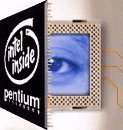"It's the classic pattern," said John Cooley, an independent design consultant who became an object of corporate ire when he set up the Synopsys User's Group.


Intel claims Internet logo parody sullies corporate image
Published July 29, 1996
Electronic Engineering Times
BY LARRY LANGE
EE Times Staff Writer
Like many a crusader before him, Robert Collins has found there's a price to be paid for ruffling corporate feathers. Collins has incurred the wrath of the legal department of the company whose products he critiques for an audience of EEs and says he's even being monitored.
A design engineer and manager of the Advanced Microprocessors Group at Texas Instruments Inc. in Dallas, Collins has created a Web site called Intel Secrets, which he said gets 22,000 hits a day.
| "Intel Secrets: What Intel Doesn't Want You to Know."
"Welcome to Packard Hell." "Windoze 95 Hate Page."
Web pages critical of companies or products - or sites on whichto post
general gripes, like the complaint board Moan and Groan Page, at www2.tsixroads.com/Moan
- are sprouting up all over the Internet like mushrooms after a rain.
Together they lay siege to high-tech companies, catching their errors,
in some cases disclosing undocumented technical information, and generally
causing enough corporate hand-wringing to warrant legal threats, electronic
monitoring and other forms of what site creators call intimidation.
"It's the classic pattern," said John Cooley, an independent design consultant who became an object of corporate ire when he set up the Synopsys User's Group. |
Intel claims Internet logo parody sullies corporate image |
Said a spokesperson for Packard Bell, itself the object of several Web sites that prominently feature the word "suck," 'The Internet offers unparalleled information, but as with any communications medium, it can have advantages and disadvantages. The increase of unauthorized Web sites illustrates one of the disadvantages."
Of course, some would argue that amid the creative chaos of the Internet - where Marshall McLuhan's vision of everyone becoming his own publisher seems truer every day - there can be no such thing as an "unauthorized" Web site. Still, as Intel knows only too well from last year's Pentium floating-point flap, cybercriticism can cause ripples that swell into tsunamis. The CPU giant was considered the 'Tylenol of the computer industry" for months after news of the Pentium glitch flew across the Internet and into the mainstream press.
"We don't want to throw cold water on the Internet. As we understand it, it is a great free-speech forum," said an Intel spokesman, who called Web content a "two-edged sword." Except for sites devised by "reputable publications," where consumers can have some level of confidence about accuracy, their credibility is questionable, he said. The data is not subject to the editorial scrutiny of established publications.
Indeed, said Christopher I.indsey, programmer and senior systems administrator for Wolfram Research Inc., the Champaign, Ill., maker of Mathematica software, "It's scary to realize that whatever work I put into my company developing a product is this open to public scrutiny and attack" from any Monday-morning quarterback with access to the Web.
"Intel will try and eliminate anything that appears to be a potential threat," Lindsey added. "If they let one site get away with questionable information, soon everyone will be doing it."
The Santa Clara, Calif., company is keeping close watch on Intel Secrets (www.x86.org), which promises information on "undocumented opcodes, undocumented bits in debug registers, processor anomalies and processor bugs" for any of Intel Corp.'s closely guarded X86 architecture.
"Intel realized that 99 percent of the 'secret information' can be gleaned from public sources," said Collins, who did work on an Intel/Acer project several years ago but said he never signed a non-disclosure agreement with either company. 'They [initially] would have loved to send me a cease-and-desist letter, but they couldn't. So when all else failed, they pulled the old 'trademarked logo' rabbit out of the hat."
The Collins site features a reworked Intel logo molded into his own form of "parody." Not surprisingly, Intel is not the least bit amused. Last week the company served notice that it has retained legal representation specifically for his case, and filed a protest with the U.S. Patent and Trademark office over use of the "spurious simulation" of the Intel logo.
"Our view is that Collins is using our logo improperly, and that he is in fact tarnishing our logo," the Intel spokesman said. Trademark infringement may not be the only issue, however. Since Collins has already changed his Intel Secrets logo once before, he sees Intel's newest volley as a continuation of a policy of harassment. Collins claims to have been harassed personally by legal reps and via e-mail by several Intel employees. He cited an alleged incident where an Intel manager tried to have him fired from Texas Instruments by reporting to a counterpart at TI on a series of "proprietary" Intel technical publications posted on Collins' site.
"TI's lawyers showed up in my office the next day," Collins said, "but I was able to prove that the documents were public documents available only as hyperlinks to an FTP site." However, he said, his Web work has not endeared him to his employers at TI, where corporate monitoring of his every Usenet activity is now a part of everyday life. He worries that "Intel might be able to convince TI that I'm a liability."
Ironically, Collins is a fan of Intel's engineers and products. "I wholeheartedly and sincerely admire their work. The processors they must have in their labs must be amazing."
Equally ironic is the fact that Intel engineers are among Collins' biggest followers. Of the 22,000 daily hits Intel Secrets has averaged over the last year, Collins said 17,400 have been directly from Intel, whose programmers get data at the site that is unavailable to them at work. One told Collins that while searching for a program that counts the number of internal cache hits/writes, he finally found a pointer to a processor program on Intel Secrets that did the job.
"What would Intel care whether a few people know their undocumented opcodes?" asked Jannes Farber, a programmer at the University of Utrecht in the Netherlands. "People can't really use them in applications, since they might not be supported in the next CPU or even in the same CPU with another serial number."
But Lindsey of Wolfram Research said, "I think that [Collins' site] is an excellent resource for a competitor of Intel's, such as Cyrix or AMD."
Corporate intimidation is nothing new to engineers who irk a company. That's what Cooley found out four years ago when he launched his e-mail-only weekly Synopsys User's Group report discussing bugs, work-arounds and opinions on EDA products.
Cooley became the target of what he calls massive backlash from Synopsys Inc. "Their lawyers came after me, by sending a letter to the company I worked for saying that I had violated a licensing agreement." Cooley convinced both his CEO and Synopsys that his intentions were aboveboard - "I wasn't revealing source codes." But to this day, his posts still garner irate calls from Synopsys, though the two have largely learned to live with each other.
By far the bearer of the largest number of corporate hate pages is Microsoft Corp. A quick search on the Web reveals dozens of pages trashing the Redmond, Wash, software behemoth. "There's all kinds of undocumented stuff on Microsoft products - mainly DOS and Windows, along with technical databases like Ralf Brown's Interrupt List," said Farber of the University of Utrecht. The site he refers to (www.cs.cmu.edu/afs/cs.cmu.edu/user/ralf/pub/WWW/files.html is a comprehensive listing of interrupt calls for IBM PCs, many undocumented.
The Windows 95 Hate Page, brainchild of Andre Granli, an engineering student at. University of Utrecht (www.uib.no/people/wolf/grana/winhate2 html, uses a blend of graphics, profanity and technical chops to get across "what's wrong with Win95."
The most notorious of the Microsoft slams is the outrageous and sometimes obscene Micro$oft Hate Page (microsoft.is.lame.org/~chris/HATE/ ), which boasts 275,000 accesses since its inception last year. The site claims that it sold out of its "F--k the skull of Mircosoft [sic]" T-shirts in one week.